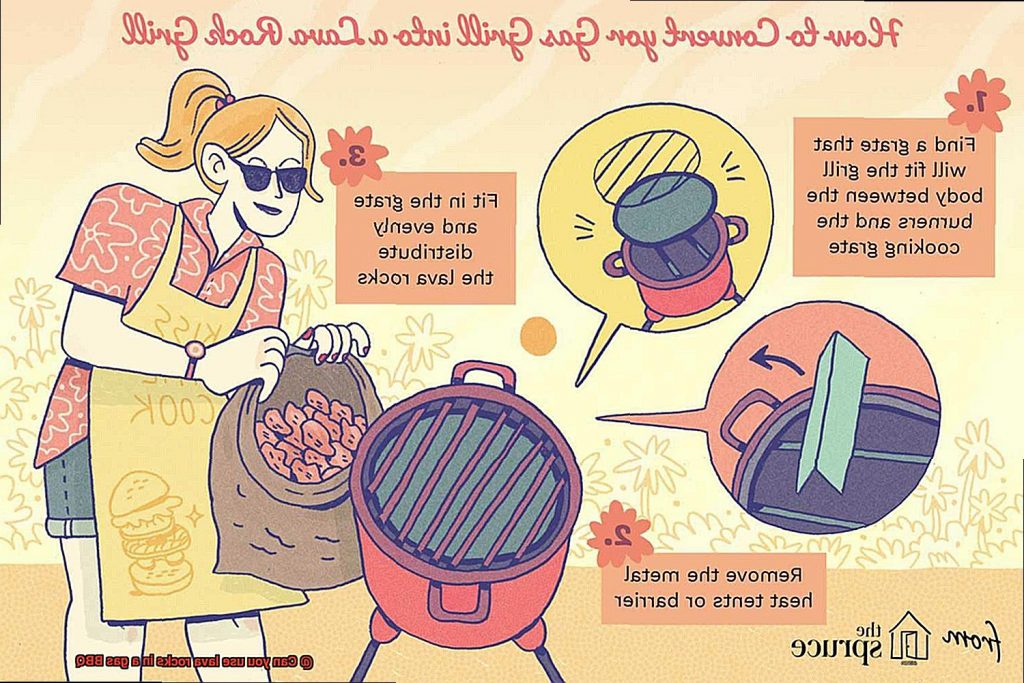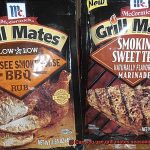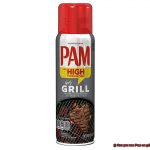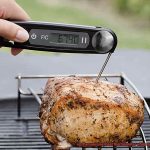Are you a grilling enthusiast always on the hunt for ways to take your BBQ game to the next level? Then you’ve probably come across the age-old debate about using lava rocks in a gas BBQ. Some swear by them, while others are skeptical. So, what’s the verdict? Can you use lava rocks in a gas BBQ?
Before we answer that question, let’s first define what exactly lava rocks are. As their name suggests, they’re rocks formed from cooled lava and are commonly used in gas grills to distribute heat evenly and retain it for longer periods. They also catch drippings and create smoke, imparting mouth-watering flavor to your food.
However, some people hesitate to use lava rocks in their gas BBQs due to safety concerns. They argue that these rocks can trap grease and debris, leading to flare-ups that could put your grill’s burners at risk. Others believe that lava rocks can obstruct the flow of gas, reducing heat output and wasting fuel.
But fear not. We’re here to provide you with all the information you need to make an informed decision. Join us as we explore the pros and cons of using lava rocks in a gas BBQ and offer tips for safe and efficient grilling.
Contents
Pros and Cons of Using Lava Rocks in a Gas BBQ
Adding lava rocks might be the solution you’ve been searching for. But before you make the switch, it’s essential to weigh the pros and cons.
Let’s start with the pros. Firstly, using lava rocks in a gas BBQ can help distribute heat more evenly throughout the grill. They absorb and radiate heat, creating a more consistent cooking temperature. This means you won’t have to worry about one side of your steak being overcooked while the other is undercooked.
Secondly, lava rocks can add a delicious smoky flavor to your food. As the drippings from your food hit the hot rocks, they vaporize and create smoke that infuses your food with a mouth-watering flavor. Imagine biting into a juicy burger with a smoky aroma and flavor – it’s simply irresistible.
Lastly, lava rocks can help protect your burners from grease and debris build-up. They act as a barrier between the burners and the food, preventing excess grease from dripping directly onto the burners and potentially causing flare-ups or damage.
However, using lava rocks also comes with some cons to consider. Firstly, they can be messy and difficult to clean. Over time, they can become caked with grease and other debris, making them challenging to remove and clean thoroughly.
Secondly, lava rocks need to be replaced regularly. As they break down over time, they become less effective at distributing heat evenly or adding flavor to your food.
Lastly, if you don’t clean your lava rocks regularly, they can become a fire hazard. Excess grease or debris buildup on the rocks can ignite and cause a fire inside your grill.
Overall, using lava rocks in a gas BBQ is a personal preference. If you’re willing to put in the extra effort and maintenance, they can enhance your grilling experience and elevate the flavor of your food. However, if you prefer a simpler grilling experience, skipping the lava rocks might be a better option for you.
To sum up, here are the pros and cons of using lava rocks in a gas BBQ:
Pros:
- Even heat distribution
- Delicious smoky flavor
- Burner protection
Cons:
- Messy and difficult to clean
- Need to be replaced regularly
- Can become a fire hazard if not cleaned regularly
Compatible Grills for Using Lava Rocks
Lava rocks might just be the answer. But before you go ahead and use them, it’s important to check if your grill is compatible. As an expert on this topic, let me guide you through some essential factors to consider.
First and foremost, check your grill’s owner’s manual to determine compatibility. Some manufacturers mention whether or not their grills can be used with lava rocks, while others may not. If your grill is compatible, it will typically have a designated area where the lava rocks can be placed – usually a tray or basket located between the burner and cooking grates.
But not all lava rocks are created equal. Look for ones that are specifically labeled as “gas grill compatible” or “for use in gas grills” to ensure you get the right type. Incorrect placement of the rocks can lead to uneven heating or flare-ups, so it’s crucial to follow the manufacturer’s instructions carefully.
It’s also important to note that older gas grills are more likely to be compatible with lava rocks, as they were a common feature in grills from previous decades. However, many newer models are also designed to work with them, so it’s always worth checking your owner’s manual before making a purchase.
While lava rocks add delicious smoky flavors and protect your burners from grease buildup, they do require regular cleaning and replacement. Neglecting them can become a fire hazard, so it’s essential to follow all safety instructions carefully.
Preparing the Grill for Lava Rocks
These igneous wonders can provide even heat distribution and add smoky flavor to your food on a gas BBQ. But before you dive in, it’s important to prepare your grill properly for the best results.
To start, gather all the necessary equipment, including gloves, a wire brush or scraper, and a metal bucket or trash can. Once you have everything ready, turn off and disconnect the gas supply to your grill. Take out the grates and flavor bars from the grill, setting them aside for later.
Now, take a moment to clean your grill thoroughly. Use a wire brush or scraper to remove any debris or grease buildup from the inside surfaces of the grill. This ensures that your lava rocks will be placed on a clean surface and provide optimal heat distribution.
Once your grill is clean, it’s time to add the lava rocks. Check your owner’s manual to make sure that your grill is compatible with them. If so, there should be a dedicated area beneath the grates where they can be placed. Use gloves to protect your hands and carefully place the rocks in an even layer covering the entire area.
Make sure that they are evenly distributed and cover the entire area. Once you have added the lava rocks, replace the flavor bars and grates.
Before turning on the gas supply and igniting the grill, double-check that everything is in place and secure. It’s also important to note that using lava rocks can increase cooking times, so you may need to adjust your cooking temperature or time accordingly.
In conclusion, preparing a gas BBQ for lava rocks is a simple process that can take your grilling game to new heights. Here are some key steps to keep in mind:
- Gather all necessary equipment
- Turn off and disconnect gas supply
- Remove grates and flavor bars
- Clean the grill
- Add lava rocks if compatible with your grill
- Replace flavor bars and grates
- Check that everything is secure before turning on the gas supply
Preheating the Grill with Lava Rocks
Before you get started, it’s important to follow some essential guidelines to ensure a safe and effective preheating process.
Firstly, cleanliness is key. Make sure to give your grill a thorough cleaning to remove any residual grease or food particles that can cause dangerous flare-ups. Once your grill is spick and span, it’s time to add the lava rocks.
Lava rocks should be added to the bottom of your grill, covering the burners. This is where the magic happens. The rocks help distribute heat evenly throughout your grill, ensuring perfectly cooked food every time.
Next, it’s time to preheat your grill for at least 15-20 minutes before placing any food on it. This allows the lava rocks to heat up evenly and reach the desired temperature. Trust us, this step is crucial for achieving those beautiful grill marks and deliciously seared meats.
It’s important to keep in mind that lava rocks retain heat for a long time after you turn off the grill. To avoid any accidents, make sure to let them cool down completely before removing them. Safety first.
And speaking of safety, don’t forget to replace your lava rocks periodically. Over time, they can become saturated with grease and food particles, leading to dangerous flare-ups. It’s recommended to replace your lava rocks every season or as needed.
Grilling with Lava Rocks
This age-old technique has been used for decades, and with good reason. Lava rocks are porous and heat-resistant, making them the perfect choice for grilling. Not only can they help distribute heat evenly, but they can also prevent potentially dangerous flare-ups.
However, before you start grilling with lava rocks, it’s essential to take some safety precautions. Here are some key things to keep in mind:
- Check your grill manufacturer’s instructions: It’s crucial to check if it’s safe to use lava rocks in your gas grill according to your grill manufacturer’s instructions. Some manufacturers may advise against using them due to potential damage or fire hazards.
- Clean the lava rocks thoroughly: Before placing them in your grill, make sure to clean the rocks thoroughly with soap and water and let them dry completely. Any leftover dirt or grease can cause flare-ups, which can be dangerous.
- Place the lava rocks evenly: Once the lava rocks are clean and dry, place them in the bottom of your gas BBQ, ensuring they cover the entire bottom of the grill evenly.
- Preheat the grill: To ensure even cooking, turn on the gas and let the grill preheat for about 10-15 minutes before placing your food on the grates.
- Consider which foods are suitable for lava rocks: Lava rocks should not be used in every grilling situation. For example, if you’re grilling delicate foods like fish or vegetables, you may want to skip using the rocks altogether. Additionally, if you’re using your grill for high-heat cooking like searing steaks or burgers, lava rocks may not be necessary.
Regular Maintenance of Lava Rocks
If you’re a grill master who enjoys the mouth-watering taste of perfectly cooked food, then you know the importance of lava rocks. They are the secret ingredient to evenly cooked and delicious food. However, to ensure that your gas BBQ grill is working at its best, you need to pay attention to the upkeep of your lava rocks. Regular maintenance is just as crucial as their placement in your grill.
Why is maintaining your lava rocks regularly so important? Firstly, it helps prevent flare-ups. Over time, grease and debris can accumulate on the rocks affecting their ability to distribute heat evenly. Cleaning the rocks frequently ensures that they are free from any build-up and ready to distribute heat evenly.
Here are some essential tips for maintaining your lava rocks:
- Clean Them After Every Use: After grilling, remove the lava rocks from the grill and place them in a container filled with warm water and dish soap. Let them soak for about 15-20 minutes to loosen any debris. Next, use a scrub brush or a sponge to gently scrub the lava rocks and rinse them thoroughly with water. Repeat this process until you are satisfied that the lava rocks are clean.
- Inspect Them Regularly: Check the lava rocks for any signs of wear and tear. Cracks or breakages indicate that it’s time to replace them. Damaged lava rocks can cause flare-ups, which can be dangerous. Additionally, damaged lava rocks may not distribute heat evenly, resulting in uneven cooking.
- Replace Them Every Season or After 10-12 Uses: Over time, lava rocks may become saturated with grease and debris, making it difficult to clean them effectively. Replacing them ensures that you have clean and functioning lava rocks every time you grill.
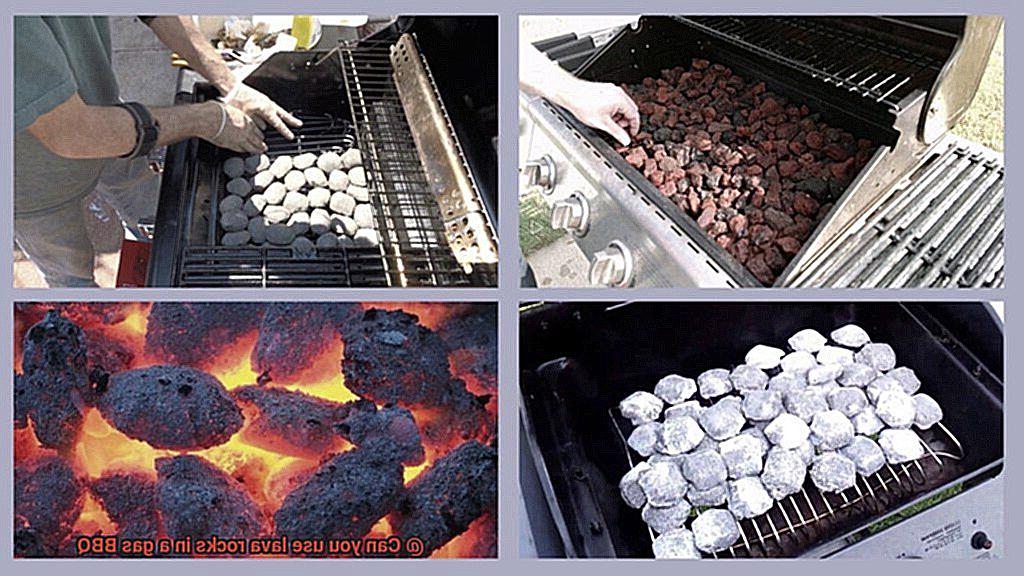
Cleaning and Replacing Lava Rocks
These porous rocks are perfect for absorbing and distributing heat, ensuring your food is cooked to perfection every time. However, as with any cooking tool, regular maintenance is crucial to keep them in top condition.
So, how do you clean and replace lava rocks in a gas BBQ? Let’s explore the process step-by-step.
Cleaning Lava Rocks
Start by removing the lava rocks from your grill and giving them a thorough brushing with a wire brush or stiff-bristled brush. This step removes any loose debris that may have accumulated over time. Next, soak them in warm soapy water for at least an hour to loosen any remaining dirt or grease. Once they’re done soaking, scrub them again with the brush to remove any stubborn stains or buildup, then rinse them thoroughly with clean water.
Inspecting Lava Rocks
Now that your lava rocks are clean, it’s time to inspect them for any signs of damage or wear. Cracks, chips, or crumbling can affect their ability to distribute heat evenly and pose a fire hazard. So, if you notice any damage, it’s best to replace those affected rocks immediately.
Replacing Lava Rocks
To replace your lava rocks, start by removing the old ones and disposing of them properly. Then measure your grill tray’s size and purchase new lava rocks that fit snugly in the tray without leaving gaps or spaces. Place the new rocks in the tray, ensuring they’re evenly distributed and level.
Regular Maintenance
Cleaning and replacing your lava rocks regularly not only improves your gas BBQ’s performance but also ensures its longevity. So make sure you add this task to your regular maintenance routine to keep your BBQ running smoothly for years to come.
Tips for Safely Using Lava Rocks in a Gas BBQ
Using lava rocks in a gas BBQ can bring a new level of flavor and performance to your grilling experience. However, it’s critical to prioritize safety when doing so. Here are some tips to ensure that you use lava rocks safely in your gas BBQ:
Choose the right size and shape of lava rocks
It is important to choose the right size and shape of lava rocks for your gas BBQ. The rocks should fit snugly in the lava rock tray and not be too close to the burners. Using the wrong size or shape can lead to uneven heating and safety hazards.
Clean your lava rocks regularly
Lava rocks can easily become clogged with grease and debris over time, which can cause flare-ups, fires, and other safety hazards. Make sure to remove them from the grill and wash them with soap and water regularly.
Replace your lava rocks when necessary
Over time, lava rocks can break down, causing uneven heating and other safety hazards. Make sure to replace them when necessary to ensure that they are functioning properly.
Use a drip tray
A drip tray placed underneath the lava rock tray can help prevent flare-ups and other safety hazards by catching any grease or debris that falls through the lava rocks. This tray should be cleaned regularly as well.
Keep an eye on your grill
Always keep an eye on your gas BBQ when using lava rocks to ensure that everything is functioning properly and there are no safety hazards. If you notice any unusual flames or smells, turn off the grill immediately and address the issue before using it again.
viM9sVucExM” >
Conclusion
After much debate, it’s time to settle the question of whether or not you can use lava rocks in a gas BBQ. While some grill enthusiasts swear by them, others have safety concerns. However, after careful consideration of the pros and cons, it’s clear that adding lava rocks to your gas BBQ can take your grilling experience to new heights.
Lava rocks are an excellent way to distribute heat evenly throughout your grill while imparting a delicious smoky flavor to your food. They also protect your burners from grease buildup, which can cause dangerous flare-ups. Of course, like any accessory, they require regular cleaning and replacement to ensure optimal performance.
Before using lava rocks in your gas BBQ, be sure to consult your owner’s manual for compatibility and follow all safety instructions carefully. Regular maintenance is crucial to prevent any potential fire hazards.
By following these simple tips for safely using lava rocks in a gas BBQ, you’ll be able to elevate your grilling game while ensuring a safe and enjoyable experience for you and your guests.

